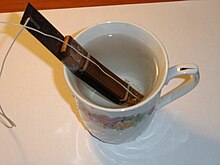Atomino (stove)

Atomino , UFO or nuclear Boilers were improvised immersion heaters , among other things, by soldiers of the National People's Army of the GDR were used. In Poland, these improvised immersion heaters are known as Buzała .
Immersion heaters were among the items that were prohibited by the army and were specifically searched for during room controls. For this reason, members of the army tinkered improvised immersion heaters to prepare hot drinks .
The name Atomino is derived from an episode of the comic series of the same name , which was published in booklet and book form in the GDR from the 1960s: Atomino heated the sea water like an immersion heater. “Now you can take it. Bravo, Atomino, what heavenly warmth! ”The surface began to steam like a bathtub, and the temperature rose rapidly. The name Ufo originated from the disc shape of the can parts used.
The manufacture of such immersion heaters from razor blades was already common practice with the civilian population in the period immediately after the Second World War, when electrical appliances were not available, and at the time many people lived in emergency apartments with no cooking facilities, so that improvised immersion heaters were the only way to heat water.
The considerable risk of an electric shock from improper use of such immersion heaters was accepted due to the emergency or forced situation.
Construction
The construction and use of illegal kettles by the NVA is documented in numerous letters and memory books. The immersion heaters mostly consisted of the two can- like packaging parts of the interchangeable transparent panels for respiratory masks or two razor blades .
The upper and lower parts of the cans or the two razor blades were connected to one another with the aid of a current-insulating plastic push button of an NBC protective suit or other non-conductive materials. The push button could be attached to the protective suit again at any time. The two metal parts were connected with the wires of a power cable. The construction was immersed in the water to be heated and then plugged into a socket or otherwise energized (e.g. via a light bulb socket). The current flowed over the water between the two metal parts of the UFO. The specific resistance of the water generated enough heat to bring a cup of water to the boil within seconds.
Web links
- Image of an atomino made from can parts in the Military History Museum of the Bundeswehr
- Image of an atomino made of can parts
- Image of an Atomino made from razor blades, confiscated in 1988
Individual evidence
- ↑ Klaus-Peter Möller: The true E: a dictionary of the GDR soldiers' language . Berlin: Lukas Verlag für Kunst- und Geistesgeschichte, 2000, p. 45 u. 210; Wolf Oschlies : How 'muckers' talk about the 'Fahne': sociolinguistic remarks on the GDR soldier jargon. Reports of the Federal Institute for Eastern Science and International Studies 23 (1987), p. 27 (booklet at Eastern European Documents online ).
- ↑ Christian Th. Müller: A thousand days with the ashes. NCOs in the NVA. Berlin: Ch. Links Verlag, 2003, p. 352; Start-up help, written by construction soldiers, autumn 1973 (Document 38). In: Bernd Eisenfeld , Peter Schicketanz : Construction soldiers in the GDR. Berlin: Ch. Links Verlag, 2011, pp. 501–508.
- ↑ Marcello Argilli: Atomino. Berlin (GDR): Kinderbuchverlag, undated [first 1970], p. 121.
- ↑ Klaus-Peter Möller: The true E: a dictionary of the GDR soldiers' language . Berlin: Lukas Verlag für Kunst- und Geistesgeschichte, 2000, p. 210.
- ↑ http://www.fernsehserien.de/bibliothek-der-sachgeschichten/haben/nachkriegszeit-16793
- ↑ Sebastian Kranich : “First listen to Christ, then to the comrades”. Building soldiers letters: Merseburg, Wolfen, Welzow 1988/89. Halle: Projekt-Verlag 188, 2006, p. 170; Volker Koop : Ten years with the "yellow stripe": Karl-Heinz Rutsch. From NVA officer to deserter. Berlin: Edition Q, 1996, p. 109f .; Peter Tannhoff: Sprutz. In the clutches of the NVA. Kiel: Ludwig, 2008, p. 68f .; Thomas Brösing: The construction soldier. Norderstedt: BoD, 2008, p. 156.
- ↑ cf. the descriptions in Klaus-Peter Möller: The true E: a dictionary of the GDR soldiers' language . Berlin: Lukas Verlag für Kunst- und Geistesgeschichte, 2000, p. 210; Peter Tannhoff: Sprutz. In the clutches of the NVA. Kiel: Ludwig, 2008, p. 68f .; Volker Koop: Ten years with the "yellow stripe": Karl-Heinz Rutsch. From NVA officer to deserter. Berlin: Edition Q, 1996, p. 109f.
